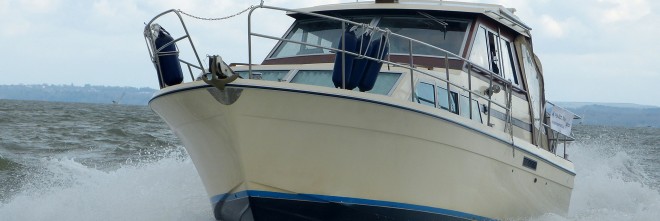Displacement Cruising
Newsletter Articles
The art of going slow!
Todays modern pace of life has us all scrambling about at a crazy pace and many do just that when on their boat. There is another way, slow is becoming the new cool, not just from the fuel that can be saved but it also means that the trip itself becomes part of the adventure, pretty much as our sailing friends have already discovered. You just need a slightly different mindset as the journey time could be considerably longer, which means a bit more planning from the outset. Consideration needs to be given to several key areas.
Planning with charts:
Take some time to ponder over the route and charts. When coastal cruising and used to travelling at 20 + knots then a 60 mile journey is a mere three hours, but if we slow to 8 knots its become nearly 8 hours at sea which can seem daunting. Perhaps anchor for lunch then, two lots of four hours suddenly seems easily achievable. The slower pace requires a bit more thought, as every mile travelled counts. So keep the route as direct as possible, take advantage of any natural break points in the journey and build in pilotage notes for extra places of refuge in the plan. In tidal waters use the tide to assist with boat speed, if against the tide come into shallower water as the tide flows slower in the shallows. Being in close to the coast is also good as the scenery will be more interesting, but carefully read any pilotage notes for dangers especially when rounding headlands as they can often have interesting currents.
If travelling offshore then it becomes really important to have enough crew for a watch system so there is time to rest. Long distances at sea to the uninitiated are tiring, anything over 24 hours for new comers can feel epic. Do note though that the motion of the boat when travelling slower can be far less tiring.
Safety:
Again offshore you may consider extra equipment or even upgrading the electronics with AIS which can give valuable additional information on other craft. Carry plenty of spares, especially fuel filters and fully fuel the boat preferably with fuel from a known source. Ensure your navigation lights work and carry spare bulbs. Talk the intended route through with all aboard; explain the basics of your plotter, how waypoints are entered and how to read your position. Ensure all the crew are familiar with how to start and stop the engines, your craft’s safety equipment locations and how to use it. You need to cover at a minimum the VHF including the DSC if fitted, flares and liferaft. If your liferaft usually lives buried in a locker, get it out so it’s to hand especially if the passage may involve darkness. For offshore passages add an EPIRB to the inventory and make sure it is registered. The RYA Sea Survival course is I think their best course, it’s a one-day ‘what if’ and the information is invaluable, lets hope you never have to use it.
Pilotage and Timing:
Pilotage is the art of exiting and entering harbours – the bit at each end of a passage, personally I still prefer a written plan, devised from a chart, rather than just relying on the plotter, I find that all the zooming in and out on the plotter to get the scale and detail that’s needed does not give me as clear a visual picture of what I actually will see as looking at a chart and sketching it. Timing plays an important role in any pilotage but especially after a longer trip, you have to be wary of fatigue and not making what you think you are seeing match what is actually there.
Provisions:
How suitable for preparing food and beverages whilst on the move is your boat? Many galleys, with some simple additions such as pan and kettle holders to keep things still, can be quickly transformed into a moving gastro delight. If your crew are not good at cooking at sea, and we are not all blessed with the ability to work effectively with motion then some simple snacks and drinks prepared beforehand will cover the essentials.
Fuel:
Fuel costs have continued to rise so a slower speed can greatly assist in controlling that cost and increasing your range. If you travel below your displacement hull speed the savings can be massive. Your hull speed is based on a simple equation of 1.34 x √water line length in feet. Travel below this and you can easily double your range – and half your costs
Weather
Lastly but most importantly you need a little more practice at reading the weather. Some cruising areas are known for having prolonged periods of settled weather, others need patience to wait for the window of opportunity, where ever you are it’s worth the wait to enjoy what can be some of the best cruising of your life.
